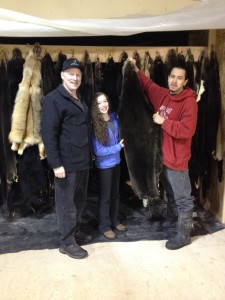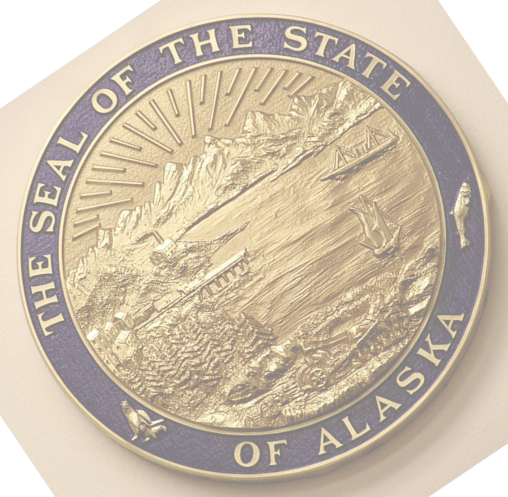
Senator Stedman and his daughter Susie look at sea otter pelts with Russell James, tannery manager with the Sitka Tribe of Alaska
Recently, I introduced Senate Bill 60, an act providing a bounty on sea otters. In Southeast Alaska, the growing sea otter population is devastating the shellfish biomass. Sea otters are the only marine mammals without blubber. As a result, the animals have a high metabolism and require large amounts of food to survive. The sea otter diet consists mainly of marine invertebrates including: crabs, clams, sea urchins, sea cucumbers, shrimp and abalone. Sea otters can consume up to 25 percent of their body weight per day. One male otter can consume up to 7,300 pounds of food per year. As of 2012, the US Fish and Wildlife Service estimates there are 25,000 sea otters in Southeast Alaska. Using an average body weight of 65 lbs. and a daily food intake of 25% of body weight, a sea otter population of 25,000 animals will consume over 148 million pounds of shellfish per year. To put that into perspective, the entire 2012 Southeast Alaska harvest in the dive and dungeness crab fisheries was only 4.8 million pounds.
In Southern Southeast, the annual population growth rate is as high as 12 – 14%. If the population continues to go unchecked, predation from sea otters inevitably threatens the future of dive fisheries and crab fisheries in Southeast; jeopardizing hundreds of jobs and tens of millions of dollars in economic activity for the region. The dramatically increasing and currently high number of sea otters has, in some areas of Southeast, depleted shellfish stocks to a degree that subsistence, personal use, sport and commercial fishing have been halted. In recent years, ADFG has closed 17 dive fishery harvest areas due to the shrinking biomass.
The Marine Mammal Protection Act (MMPA) of 1972 removed marine mammals from the State of Alaska’s management denying most Alaskans the opportunity to harvest sea otters. Section 101 of the MMPA provides an exemption for Alaska Natives to harvest sea otters for subsistence and artisanal purposes. 2012 was the highest reported subsistence harvest of sea otters in Southeast Alaska with 842 animals taken. According to the United States Fish and Wildlife Service (USFWS), the potential biological removal of sea otters from Southeast Alaska is 2,180 animals per year. The potential biological removal is a calculation used to determine the maximum number of animals, not including natural mortalities, that may be harvested from the sea otter stock while maintaining its optimal sustainable population. In the absence of any realistic effort by the USFWS to provide a sustainable harvest management regime for sea otters, it is my intention through the introduction of SB 60 to incentivize the lawful harvest of sea otters by Alaska Natives to, at the very least, reach the potential biological removal target. The incentive will come in the form of a $100 reward for each sea otter tagged to reduce the cost of harvesting and processing the pelt.
To read the McDowell Group report on Sea Otter Impacts on Commercial Fisheries in Southeast Alaska prepared for the Southeast Alaska Regional Dive Fisheries Association, click here.

Comments are closed